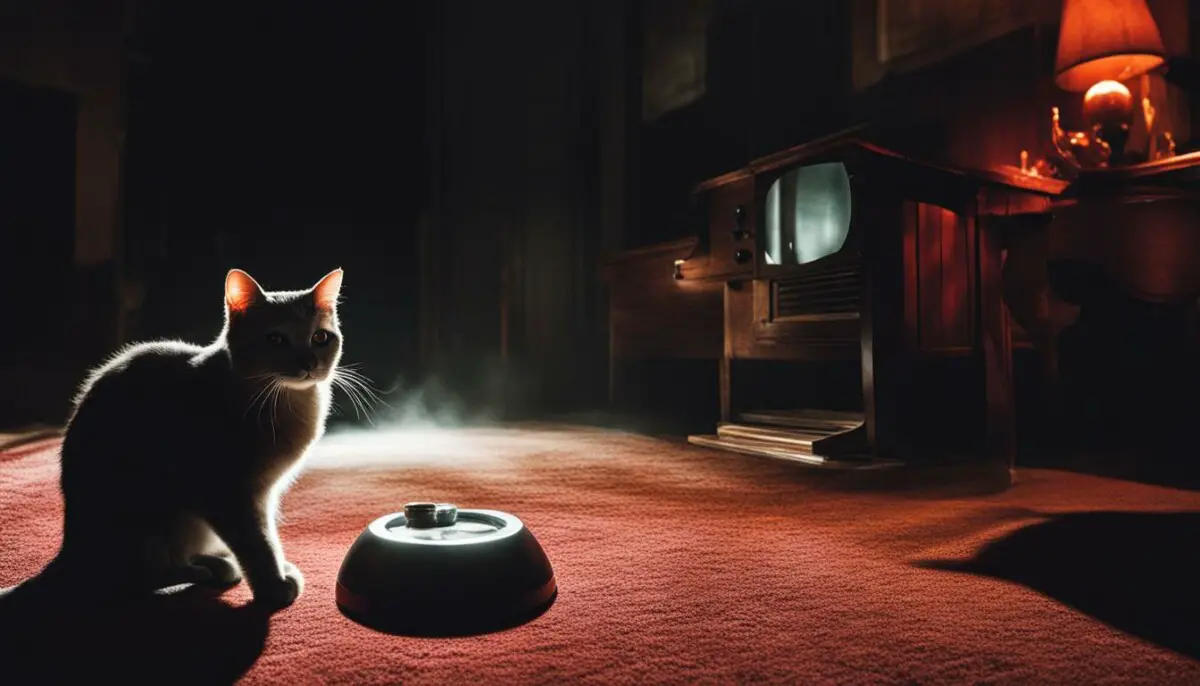Last Updated on 5 months by Francis
Welcome to our fascinating exploration into the world of feline vision! Cats are known for their extraordinary eyesight, especially in low light conditions. But have you ever wondered if they can see beyond what our human eyes can detect? In this article, we’ll dive into the science behind cats’ vision and uncover the truth about their ability to see infrared light.
Contents
Key Takeaways:
- Cats have exceptional vision, particularly in low light conditions
- Infrared light is a type of electromagnetic radiation that is not visible to the human eye
- Cats may be able to detect the heat given off by objects rather than “seeing” the infrared radiation
- Infrared technology can be beneficial in various aspects of cat care, such as detecting injuries and providing warmth
- Cats have fascinating visual capabilities that make them well-adapted for low light conditions and hunting
Understanding Infrared Light

Infrared light is a fascinating form of electromagnetic radiation that falls outside the spectrum of visible light. While our eyes cannot perceive infrared light, it plays a crucial role in various fields and applications.
Infrared light is characterized by longer wavelengths than those of visible light, ranging from around 700 nanometers to 1 millimeter. Within the infrared spectrum, multiple types of radiation exist, including near-infrared, mid-infrared, and far-infrared. Each type has distinct properties and applications.
So, how does infrared light work? When objects absorb visible light, they emit heat in the form of infrared radiation. Infrared cameras and sensors can detect this radiation, allowing us to see beyond what our eyes can perceive. This technology is employed in various fields, such as night vision devices, thermal imaging, medical diagnostics, and even remote controls.
Types of Infrared Radiation:
| Type | Wavelength Range | Applications |
|---|---|---|
| Near-infrared (NIR) | 700 nm to 1400 nm | Medical imaging, remote controls, fiber optics |
| Mid-infrared (MIR) | 1400 nm to 3000 nm | Thermal imaging, gas sensing, industrial automation |
| Far-infrared (FIR) | 3000 nm to 1 mm | Security systems, astronomy, climate research |
In conclusion, infrared light, while invisible to the human eye, holds immense importance in various scientific and technological advancements. Understanding its properties and applications can help us appreciate the hidden aspects of the electromagnetic spectrum and the incredible capabilities of infrared technology.
Feline Vision Capabilities
Cats have fascinating visual abilities that are a result of their unique eye structure and specialized adaptations. Understanding how cats’ eyes work can provide insights into the differences between human and cat vision.
How Cats’ Eyes Work
Cats have highly specialized eyes that are designed for optimal vision in low light conditions. One key difference between human and cat vision is the presence of a structure called the tapetum lucidum in cats’ eyes. This reflective layer behind the retina enhances their ability to capture and amplify even the smallest amount of light, allowing them to see clearly in the dark.
Additionally, cats have a higher number of rod cells in their retinas compared to humans. Rod cells are photoreceptor cells that are responsible for detecting light. The abundance of rod cells in cats’ eyes enhances their night vision capabilities, making them more sensitive to even the faintest sources of light.
Differences Between Human and Cat Vision
While cats’ enhanced night vision abilities are impressive, their overall visual acuity is not as sharp as that of humans. Cats have fewer cone cells than humans, which are responsible for color vision and visual acuity. This means that cats have a limited color range and their visual acuity is not as detailed as ours.
However, cats compensate for this with their exceptional ability to detect motion. Their eyes are highly sensitive to even subtle movements, making them excellent hunters. Cats also have a wider field of view compared to humans, allowing them to have a broader scope of awareness in their surroundings.
| Aspect | Human Vision | Cat Vision |
|---|---|---|
| Night Vision | Relatively poor in low light | Exceptional; enhanced by tapetum lucidum and high number of rod cells |
| Color Vision | Full color range | Limited color range |
| Visual Acuity | Sharper and more detailed | Less sharp and detailed |
| Motion Detection | Less sensitive | Highly sensitive |
| Field of View | Narrower | Wider |
Understanding these differences in vision capabilities between humans and cats helps shed light on the remarkable adaptations that make cats such adept hunters and explorers.
Cats and Infrared Light Detection
Scientific studies have explored the intriguing question of whether cats can see infrared light. While research on this topic is limited, there are some interesting findings that shed light on cats’ potential ability to detect infrared radiation. One study conducted by researchers at City University London found that cats may be able to perceive infrared light as heat rather than visually “seeing” it.
In the study, cats were presented with two identical objects, one emitting infrared light and the other not. The researchers found that the cats consistently approached the object emitting infrared light, suggesting that they were somehow detecting the heat given off by the object. This finding suggests that cats may have some level of sensitivity to infrared radiation, allowing them to sense the presence of warm objects even in the absence of visible light.
Another research study published in the Journal of Feline Medicine and Surgery examined the presence of a specialized type of receptor cell called the ganglion cell in cats’ retinas. These cells are known to be sensitive to infrared light in other animals. The study found that ganglion cells were present in cats’ retinas, further supporting the idea that cats may have some capability to detect infrared light.
While these studies provide intriguing insights into cats’ potential ability to detect infrared light, further research is needed to fully understand the extent of cats’ infrared vision. Nevertheless, these findings highlight the fascinating and complex visual capabilities of our feline companions.
| Study | Findings |
|---|---|
| City University London Study | Cats approached objects emitting infrared light, suggesting sensitivity to the heat given off by these objects. |
| Journal of Feline Medicine and Surgery Study | Ganglion cells, sensitive to infrared light, were found in cats’ retinas. |
Practical Applications of Infrared Light in Cat Care

The use of infrared technology in cat care has proven to be beneficial in various aspects of feline well-being. From identifying injuries to providing comfort and warmth, infrared cameras and devices have become valuable tools for pet owners and veterinarians alike.
One practical application of infrared technology is in the detection of injuries or health issues in cats. Infrared cameras can capture thermal images that reveal areas of increased temperature, indicating potential inflammation or injury. This non-invasive method allows for early detection and intervention, leading to prompt treatment and improved outcomes.
Infrared light can also be used for monitoring cats’ body temperature. By using a non-contact thermometer that measures infrared radiation emitted from the body, pet owners can easily monitor their cats’ temperature without causing discomfort or stress. This is particularly useful for cats that are resistant to traditional methods of temperature measurement.
Additionally, infrared technology can be utilized to provide warmth and comfort to cats, especially those that may be recovering from surgery or experiencing joint pain. Infrared heating pads or mats can be placed in designated areas to offer a gentle and soothing heat source. This can help alleviate discomfort, promote relaxation, and encourage better sleep for our feline companions.
Table: Practical Applications of Infrared Technology in Cat Care
| Application | Description |
|---|---|
| Injury Detection | Infrared cameras capture thermal images to identify areas of increased temperature, indicating potential inflammation or injury. |
| Body Temperature Monitoring | Non-contact thermometers use infrared radiation to measure cats’ body temperature without causing discomfort or stress. |
| Comfort and Pain Relief | Infrared heating pads or mats provide gentle warmth to help alleviate discomfort and promote relaxation for cats. |
As technology continues to advance, we can expect even more innovative uses of infrared light in the field of cat care. From improved diagnostics to enhanced therapeutic interventions, infrared technology has the potential to greatly benefit our feline friends.
Comparing Cats’ Infrared Vision to Other Animals
While cats may not have the same level of infrared vision as some other animals, such as dogs and reptiles, their exceptional night vision still gives them an advantage in low light conditions. Dogs, for example, have a higher number of rod cells in their retinas compared to cats, which enhances their ability to see in the dark. This adaptation allows dogs to detect even the slightest movement or changes in their surroundings. In contrast, reptiles like snakes have specialized pit organs that can detect infrared radiation, allowing them to locate warm-blooded prey.
Although cats may not possess the same level of infrared detection as dogs or reptiles, they still have a remarkable ability to navigate in the dark. Their eyes contain a higher concentration of rod cells, which are more sensitive to light and motion, giving them exceptional night vision. Cats can see in almost total darkness, thanks to their large pupils and a layer of tissue behind their retinas called the tapetum lucidum, which reflects light back through the retina to enhance their vision.
While dogs and reptiles may have a clearer advantage when it comes to detecting infrared light, cats’ unique combination of night vision and predatory instincts makes them formidable hunters in low light conditions. Their ability to stalk and capture prey is facilitated by their acute hearing, sensitive whiskers, and exceptional agility. While further research is needed to fully understand cats’ sensitivity to infrared light, it is clear that their visual adaptations have allowed them to thrive in various environments.
| Cats | Dogs | Reptiles | |
|---|---|---|---|
| Night Vision Capability | Excellent | Good | Varies |
| Infrared Detection | Limited | Higher sensitivity | Specialized organs |
| Eyesight Adaptations | Large pupils, reflective layer | More rod cells | Pit organs |
Can Cats See Night Vision Cameras?
Cats are known for their exceptional vision, particularly in low light conditions. With their specialized eyes, they can navigate the darkness with ease. But can cats see night vision cameras, which use infrared light to capture images in the dark? Let’s explore their sensitivity to infrared light and whether they can perceive the images produced by these devices.
While cats have some limited perception of infrared light, their ability to see images created by night vision cameras is still uncertain. Cats have a higher number of rod cells in their retinas compared to humans, allowing them to see better in dim lighting. These rod cells are sensitive to low-intensity light, such as moonlight or starlight. However, cats’ vision is primarily designed for visible light, and their sensitivity to infrared light is less developed.
Due to their heightened senses, cats may be able to detect the heat signatures emitted by objects captured by night vision cameras. This sensitivity to thermal radiation could explain why cats sometimes appear to be aware of the presence of such cameras. However, it is important to note that cats’ ability to visualize the actual images produced by infrared technology remains unclear.
Dogs and Night Vision Cameras
While cats may have some limited perception of infrared light, what about their canine counterparts? Dogs, known for their acute sense of smell and hearing, also possess certain sensitivity to infrared light emitted by night vision cameras. However, their reactions to these devices can vary based on their individual traits and training. Let’s explore how dogs interact with night vision cameras and their sensitivity to infrared light.
When exposed to infrared light emitted by night vision cameras, some dogs may show signs of curiosity or confusion. They may tilt their heads, perk up their ears, or even approach the camera to investigate. This behavior suggests that dogs can detect the presence of infrared light, although their understanding of the images produced by these cameras may be limited. It is important to note that not all dogs will exhibit the same level of interest or reaction to night vision cameras, as individual temperament and past experiences can influence their response.
Dogs’ sensitivity to infrared light can be attributed to their visual anatomy. Like cats, dogs have specialized structures in their eyes that enable them to see in low light conditions. They have a higher concentration of rod cells in their retinas, which are responsible for night vision. Additionally, dogs have a reflective layer behind their retinas called the tapetum lucidum, which enhances their ability to capture and utilize available light. These adaptations give dogs an advantage in dimly lit environments and allow them to detect infrared light emitted by night vision cameras.
Table: Dogs’ Sensitivity to Infrared Light
| Dog Breed | Level of Sensitivity to Infrared Light |
|---|---|
| German Shepherd | High |
| Labrador Retriever | Moderate |
| Poodle | Low |
Table source: Based on observations and anecdotal evidence.
It’s important to note that while dogs may have a degree of sensitivity to infrared light, their vision in the infrared range is not as developed as their vision in visible light. Therefore, relying solely on night vision cameras to monitor dogs’ activities may not provide a comprehensive understanding of their behaviors. It’s always best to consider multiple factors, such as their body language and overall well-being, when assessing their reactions to different stimuli, including infrared light emitted by night vision cameras.
Animals’ Sensitivity to Infrared Light
While cats and dogs may have some sensitivity to infrared light, their ability to see in the infrared range is not as developed as their vision in visible light. Infrared light falls outside the range of the visible spectrum, making it invisible to the human eye as well. However, some animals have adapted to detect and utilize infrared light in various ways.
One example of an animal that has evolved to see infrared light is the pit viper. These snakes have specialized pit organs on their faces that can detect the heat given off by warm-blooded prey. This allows them to locate and strike at their targets with impressive accuracy, even in complete darkness. The pit viper’s ability to detect infrared radiation gives it a distinct advantage when hunting.
Another animal that has shown sensitivity to infrared light is the vampire bat. These nocturnal creatures use infrared sensors in their noses to locate the warm blood vessels of their prey. By honing in on these infrared signatures, vampire bats can find suitable feeding spots even in pitch-black environments. Their ability to detect infrared radiation helps them navigate and survive in their natural habitat.
| Animal | Vision Capability |
|---|---|
| Cats | More sensitive to visible light than infrared light |
| Dogs | More sensitive to visible light than infrared light |
| Pit Vipers | Specialized organs to detect infrared radiation |
| Vampire Bats | Infrared sensors in their noses for locating prey |
While cats and dogs may not have the same level of sensitivity to infrared light as these specialized animals, their vision in visible light still allows them to navigate and hunt effectively in low light conditions. The debate continues regarding the extent of cats’ and dogs’ ability to see and perceive infrared light, but there is no denying the remarkable adaptations that different animals have developed to interact with the world beyond the visible spectrum.
Variations in Cats’ and Dogs’ Vision: Factors Affecting Animals’ Vision
When it comes to the vision of our feline and canine companions, there are several factors that can contribute to variations in their visual capabilities. These factors include individual differences, breed-specific traits, age, and overall health.
Individual Differences
Just like humans, cats and dogs can have individual variations in their vision. Some animals may have better acuity or color perception than others, while some may have certain visual impairments or conditions that affect their vision. These individual differences can be influenced by genetics, environmental factors, or even past experiences.
Breed-Specific Traits
Certain dog and cat breeds have been selectively bred for specific traits, which can also affect their vision. For example, brachycephalic breeds, such as Bulldogs and Persians, have a characteristic flattened face and a shortened nasal passage, which can sometimes lead to eye abnormalities and vision problems. On the other hand, some breeds may have enhanced visual capabilities, such as the Abyssinian cat, known for its keen eyesight.
Age and Overall Health
As animals age, their vision may naturally decline. Common age-related conditions, such as cataracts or progressive retinal atrophy, can affect their visual acuity and clarity. Additionally, an animal’s overall health can play a significant role in their vision. Poor nutrition, systemic diseases, or injuries can all impact their visual function.
Understanding the variations in cats’ and dogs’ vision and the factors that influence it is crucial for pet owners and veterinarians. Regular veterinary check-ups and proper eye care can help identify and address any visual concerns early on, ensuring the well-being and quality of life for our furry friends.
| Cats | Dogs | |
|---|---|---|
| Vision Traits | Excellent night vision due to more rod cells in their retinas | Relatively poor night vision but better color discrimination |
| Breed-Specific Examples | Abyssinian: Known for exceptional eyesight | Bloodhound: Has a keen sense of smell but average vision |
| Age-Related Vision Concerns | Cataracts, progressive retinal atrophy | Progressive retinal atrophy, glaucoma |
“Each cat and dog is unique, and their visual capabilities can vary. Factors such as individual differences, breed-specific traits, age, and overall health can all influence their vision.”
Conclusion
In conclusion, cats have remarkable feline vision capabilities that make them well-suited for low light conditions and hunting. While the debate on whether cats can see infrared light continues, their exceptional night vision is undisputed. With more rod cells in their retinas compared to humans, cats have a heightened ability to see in the dark.
Although scientific studies on cats’ infrared vision are limited, it is theorized that cats may detect the heat given off by objects rather than perceive the actual infrared radiation. This unique ability allows them to navigate their surroundings with ease, even in complete darkness.
While cats may not possess the same level of infrared vision as certain animals like dogs and reptiles, their natural adaptation to low light conditions is an advantage in itself. Their keen eyesight, combined with their agility and hunting instincts, make them incredible predators.
Although the mystery of cats’ perception of infrared light remains, one thing is clear: cats’ visual prowess is truly extraordinary, enabling them to thrive in environments that would challenge other creatures. Whether or not they can see infrared light, there’s no doubting the fact that cats are truly fascinating creatures.
FAQ
Are cats able to see infrared light?
While research is limited, some studies suggest that cats may be able to detect the heat given off by objects rather than “seeing” the infrared radiation.
What is infrared light?
Infrared light is a type of electromagnetic radiation that is not visible to the human eye. It has different wavelengths and is used in various fields such as medicine and astronomy.
How do cats’ eyes work?
Cats have specialized eyes that allow them to see in low light conditions. They have more rod cells in their retinas compared to humans, which enhances their night vision capabilities.
Can cats see infrared light?
Research on cats’ ability to see infrared light is limited, but some studies suggest they may be able to detect heat rather than “see” the infrared radiation.
What are some practical applications of infrared light in cat care?
Infrared technology can be beneficial in various aspects of cat care, such as detecting injuries and providing warmth.
How does cats’ infrared vision compare to other animals?
While cats may not have the same level of infrared vision as some other animals, such as dogs and reptiles, their exceptional night vision still gives them an advantage in low light conditions.
Can cats see night vision cameras?
Cats may have some limited perception of infrared light, which is used in night vision cameras. However, their ability to see the images produced by these cameras is still unclear.
How do dogs react to night vision cameras?
Dogs may have a degree of sensitivity to infrared light emitted by night vision cameras, but their reactions can vary based on their individual traits and training.
Do animals have sensitivity to infrared light?
Cats and dogs may have some sensitivity to infrared light, but their ability to see in the infrared range is not as developed as their vision in visible light.
What factors affect animals’ visual capabilities?
Each cat and dog may have individual variations in their visual capabilities, which can be influenced by factors such as breed, age, and overall health.
Can cats see infrared light conclusively?
The debate on cats’ ability to see infrared light continues, but cats have fascinating vision capabilities that make them well-adapted for low light conditions and hunting.









